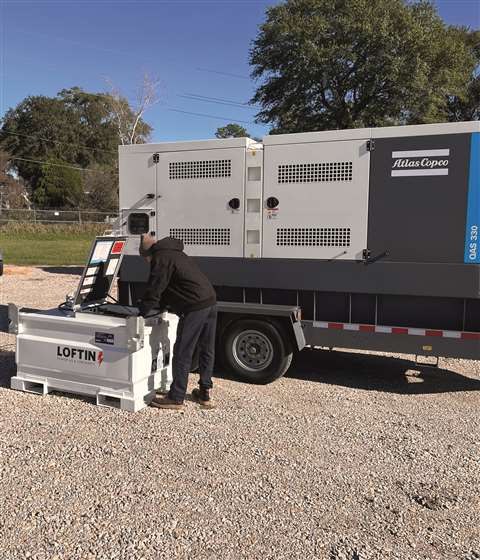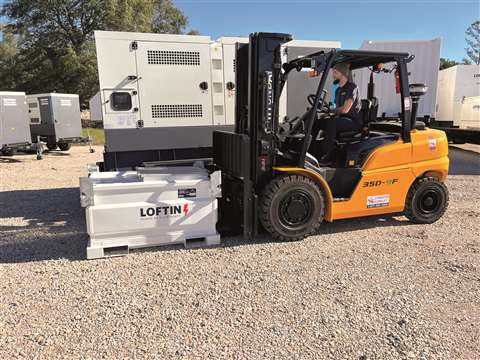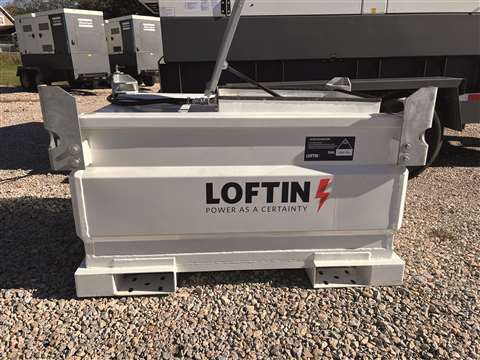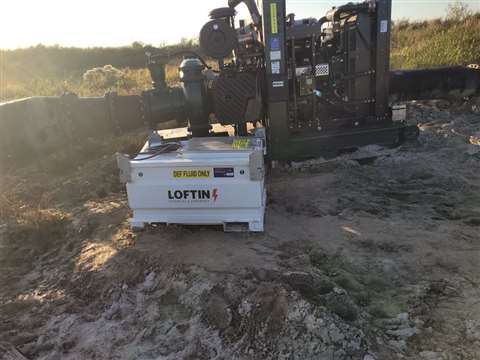Loftin Equipment develops auxiliary system to refill DEF, diesel tanks
28 February 2023
 Loftin Equipment’s new Loftin Automated DEF System, or LADS, was developed to help keep pumps and gen-sets on the job longer by refilled DEF as needed. A dual fluid model for DEF and diesel fuel is also available. (Photos: Loftin)
Loftin Equipment’s new Loftin Automated DEF System, or LADS, was developed to help keep pumps and gen-sets on the job longer by refilled DEF as needed. A dual fluid model for DEF and diesel fuel is also available. (Photos: Loftin)
Loftin Equipment Co. has developed a solution to help operators keep their engine-driven pump and generator sets running as designed – regardless of location. For the full-service engine distributor that’s used to working with customers located within its regional sales territory, the new Loftin Automated DEF System (LADS) is a unique product line that it plans to sell globally.
Based in Phoenix, Ariz., and with locations in Nevada, Texas and New Mexico, Loftin is a distributor for Kohler Industrial, Kubota and Scania diesel engines and tanks from Unity Fuel Solutions. Three years ago, one of its largest customers approached Loftin’s Houston office with a request.
“The customer was looking for a solution for DEF (diesel exhaust fluid) on its pump packages,” said Nathan DeMartino, engine sales manager for Engines & Portable Tanks at Loftin’s Houston branch. “The pumps were out in a mine and not only were they remote, but staff needed special certifications just to fill the tanks. The fuel tanks had enough for a 48-hour run time, but they found they needed to refill the onboard DEF tanks more often.”
The Loftin team got to work on a solution, for which they drew heavily on their in-house expertise with engines and electrical systems. In late 2020, they delivered a prototype system to the customer.
After about six months in the field, DeMartino said the customer loved the solution — so much so that he realized it was rarely ever talked about.
“That’s always good news when you put something out in the field for the first time,” he said.
DEF solution
With more than 50 units now on jobsites around the country, the company has officially branded the system LADS. Customer feedback has helped the design evolve since the first prototype was hauled out to a mine site, but it has stayed true to the original concept. It reads the level in the onboard DEF tank and will automatically refill it from a bulk tank, helping make long unattended run times possible. The system stops the refilling process when the bulk tank reaches a certain level, at which point it will need to be refilled.
DeMartino said Loftin’s engine application experience helped ensure a set up was easy and trouble free for the customer: The operator simply connects to the engine and selects the engine brand and model in the control panel.
 Forklift pockets help get LADS into position on the jobsite.
Forklift pockets help get LADS into position on the jobsite.
While the electronic system is designed to work with any tank, Loftin sells LADS as a package complete with a protective steel outer shell and an HDPE poly plastic inner tank in capacities up to 1200 gal. A stainless-steel inner tank is optional. The system can be sized to keep a pump running for a couple of days or up to a week before the bulk tank itself needs to be topped off.
Loftin uses a smart controller with spare ports so the customer can add telematics if desired.
“LADS can read the CAN system of any major engine,” said DeMartino. “We have 25 different engines listed in the control panel. You hook the harness up to the engine, and that harness runs to the tank and connects to our control system. When you power it up and select the engine you want, it will start monitoring the pump.”
Stainless-steel quick disconnects are used throughout and the system was designed with a 110% containment capacity in the event of a spill. The 20-ft. DEF-dispensing hose runs from the auxiliary tank to the pump engine’s onboard DEF tank in a design that helps keep dirt and debris out.
“We’re engine people and we’ve seen how the dust in Midland-Odessa can cause havoc once it gets into the DEF tank,” he said. “Contaminants are the death of DEF.”
The operator can preset the parameters at which the onboard tank gets refilled, but DeMartino said that’s typically at 30%. The system then draws DEF out of the bulk tank until the pump’s onboard tank reaches 60% and then it will automatically turn off.
“That’s a benefit of living in the middle,” he said. “There’s no reason to fill the onboard tank up to 100% because you’ve already got hundreds of gallons of DEF sitting there. Stopping it early avoids any spills from overfilling due to a lag in communication or anything else.
“Designing the control system took us the longest time. We have sensors in the bulk tank that’ll let you know when it’s empty and will keep the pump from running. We also have an ambient temperature sensor so if it’s too cold the pump won’t run. If the pump runs too long, the system will recognize that, turn the pump off and throw a code. The pump shouldn’t have to run more than a couple of minutes to refill the onboard tank.”
 LADS is a global product for Loftin Equipment.
LADS is a global product for Loftin Equipment.
The company offers a couple of options to ensure reliable operation in cold temperatures that can be installed during assembly or retrofitted later. The standard kit is good to -20 F and includes wraps for the tank and hose.
“There are not many products out there that will fill this need,” said DeMartino. “We do a lot with engines, and we know the people who are out in the field operating these pumps. We worked to design a solution that was extremely simple and easy to operate. The quick start guide we developed shows there’s a couple points of contact and you’re ready to rock. We could have done a lot of stuff to make it crazier, but ultimately that raises the cost and its complexity and that’s not what we wanted to do.”
Dual tank, too
LADS is also available in a dual-tank arrangement, keeping diesel and DEF in reserve.
“We have found that right now, customers have plenty of fuel tanks and they’ve been buying the 100 gal. LADS system to set next to their fuel tanks,” said DeMartino. “But as they progress into Tier 4 final and even Tier 5 at some point, they are using more DEF so they’re getting rid of their old fuel tanks in favor of a dual-fluid set up. The tank on the front side is for diesel and the back side is where you can get your DEF.”
 Originally developed for diesel engined pumps, LADS will also support gen-sets.
Originally developed for diesel engined pumps, LADS will also support gen-sets.
Loftin sized the dual-fluid system to dispense at a 10% ratio, in other words, a 1000 gal. diesel fuel tank gets a 100 gal. DEF tank.
“That ratio might be high, but an operator could run into a situation where they’re running that high and we’d rather be cautious,” he said. “Customers can place it right next to a unit and however long a thousand gallons of diesel’s going to last, the DEF will be keeping up, automatically refilling when needed.”
DeMartino said some of the LADS field units have been installed on generators, but it’s on remote diesel-powered pumps that the Loftin system really shines.
“The normal jobsite where somebody’s going in everyday is probably not where this thing’s going to live,” he said. “It really starts to make sense when you don’t want or don’t have the ability to send someone there every day.
“LADS does really well in remote or hard-to-reach facilities. Right now, they’re working in mines where having someone go in every 12 hours and fill it up just isn’t realistic. We also have them in refineries, where again you can’t just roll up to the tank and top it off. It either must be refinery personnel or you have to go through the process of getting on site. We’re also talking with a company in Canada that does remote power generation work and they actually helicopter in all of the fuel and equipment.”
STAY CONNECTED




Receive the information you need when you need it through our world-leading magazines, newsletters and daily briefings.
POWER SOURCING GUIDE
The trusted reference and buyer’s guide for 83 years
The original “desktop search engine,” guiding nearly 10,000 users in more than 90 countries it is the primary reference for specifications and details on all the components that go into engine systems.
Visit Now
CONNECT WITH THE TEAM










